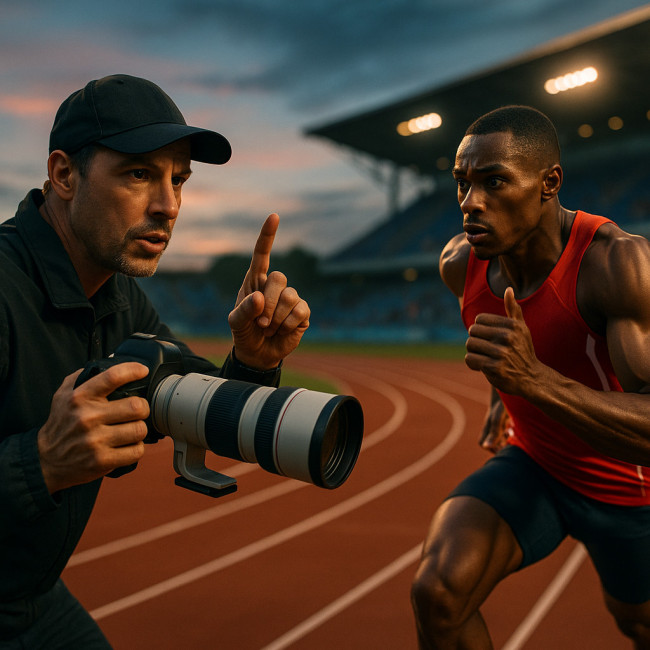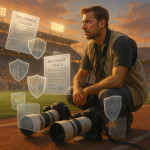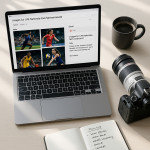Briefing elite athletes: clear cues for smoother high-intensity photo shoots
Elite athletes move fast and cannot afford misunderstandings. By mastering concise briefings and action-ready cues, you will capture decisive moments without slowing down performance or burning goodwill. Follow this step-by-step guide to build trust, nail timing, and leave the venue with a card full of hero shots.
Why precise athlete briefings decide the whole outcome
Professional competitors operate on split-second margins. A poorly timed instruction can cost them energy, focus, or even injury risk. Photographers who respect that reality earn repeat calls from agents, sponsors, and editorial desks. Clear cues achieve three wins:
- Performance integrity: athletes stay in optimal rhythm and avoid unnecessary retakes.
- Peak expressions: you freeze grit, acceleration, and emotion exactly when they crest.
- Production efficiency: fewer missed frames mean shorter retouch queues and faster client delivery.
Pre-shoot groundwork: set the stage before arriving
Research the athlete's training cycle
Speak with the coach or performance analyst at least a week out. Learn the athlete's micro-cycle: taper days, explosive sessions, and planned rest windows. Schedule the shoot inside a medium-intensity block whenever possible. That slot balances dynamism with reduced injury concerns.
Build a rapid-fire shot list
List your mandatory frames—brand logo, key sponsor apparel, signature move—then mark the physical demand of each. Arrange from least to most taxing. The approach mirrors the gear-roadmap batching strategy many pros already use to save battery life and grip strength.
Share a one-page athlete brief
| Cue element | Ideal length | Example | Why it works |
|---|---|---|---|
| Action verb | 1–2 words | “Explode” | Triggers a known movement pattern instantly. |
| Visual aid | 1 image | Pose sketch | Eliminates linguistic confusion across languages. |
| Temporal flag | 3–5 sec count | “3-2-1-Go” | Aligns shutter with peak effort every time. |
| Safe-stop cue | Single clap | “Stop” hand signal | Allows immediate halt to avoid fatigue or strain. |
Crafting crystal-clear cues the athlete will actually hear
Time cues with action windows
Every sport offers predictable phases—acceleration, max velocity, deceleration. Plan cues to fire just before transition points. For a 100 m sprinter, calling “Drive!” at step eight captures the explosive lean without bleeding into upright running form.
Choose verbal, visual, or tactile signalling wisely
- Verbal: Works in controlled arenas but fails in roaring stadiums. Use a crisp keyword, never a sentence.
- Visual: Coloured flags, LED wands, or hand signals shine when headphones block out noise during warm-ups.
- Tactile: A gentle tap on a swimmer's starting block can replace a shout in echo-heavy pools.
Carry backups. If the PA system drowns your voice, switch to the brightly lit wand. Redundancy mirrors the safety mindset in sports-photographer insurance checklists.
On-set workflow that respects performance and deadlines
Sync with warm-up routines
Arrive early, watch the athlete stretch, and note natural rhythm. Align test shots with their dynamic drills instead of asking for static poses. They stay warm; you dial in exposure. Everybody wins.
Run live feedback loops without breaking focus
Use tethered preview on a sideline tablet. While assistants tag selects with AI-powered metadata, you give the athlete a quick thumbs-up. Affirmation builds momentum; excessive chit-chat breaks flow.
“The best sports photographers are almost invisible. They guide with gestures, not monologues.” — veteran track coach Louis Pérez
After the shutter: review, recovery, and retention

Thank the athlete and staff immediately. Offer a 20-frame preview within 24 hours—ideally watermarked proofs in a private gallery. This speed echoes the fast turnaround expectations highlighted in pre-production questionnaire workflows. Fast previews help coaches analyse form and give you valuable feedback before final edits.
Store cues and timing data
Log which cues triggered the cleanest shots. Over time you build a personalised playbook for each athlete. The next briefing takes five minutes, not twenty.
Common mistakes & fast fixes
- Overloading instructions: Strip jargon. One cue at a time.
- Ignoring rest intervals: Allow at least 30 sec between maximal efforts.
- Standing in trajectory lines: Mark safe lanes with cones.
- Skipping audio tests: Boom mics or megaphones prevent muffled cues.
- Forgetting brand guidelines: Track logo visibility just as strictly as focus.
Bring the right allies on set
A lean crew keeps communication clean. At minimum:
- One assistant for lighting and flagging cues.
- One digital tech to double-back SD-card copies and flag selects.
- Optional brand rep to approve real-time framing—helps avoid retakes later.
Interactive Quiz: test your athlete-briefing IQ
FAQ
- How early should I send the shot list?
- At least 48 hours in advance so coaches can flag risky moves or timing conflicts.
- What if stadium noise blocks verbal cues?
- Switch to colour-coded flags or LED wands—tested before the athlete arrives.
- Can I combine sponsor product shots with performance images?
- Yes, but batch them at the start when the athlete is fresh and logos are pristine.
- Where can I find seasoned sports photographers for collaboration?
- Check the sports photographers directory to view portfolios and availability in seconds.
- Do I need special insurance for trackside shoots?
- Absolutely. Coverage protects gear, liability, and often satisfies venue contracts.
Level up your next shoot
Master these cue tactics and watch your keeper rate soar. Need more action-tested ideas? Browse our guide on live-shoot risk management for additional safeguards.
Ready to brief like a pro? Contact us to receive a printable one-page athlete cue sheet and start planning your next high-intensity session today.











